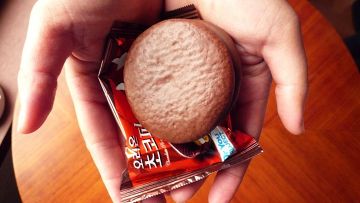
North Korean leader Kim Jong Un looks at a biscuit as he provides field guidance at Foodstuff Factory No. 354 of the Korean People’s Army in this undated photo released by North Korea’s Korean Central News Agency (KCNA) in Pyongyang on November 17, 2013. (KCNA/Reuters)
The North Korean border has never been a hospitable place. It’s home to mines, guard towers and guns — all of it an intractable symbol of the animosity between the North and the South. But just six miles into North Korea sits a sprawling complex of factories, where today a very different type of struggle is underway between the nations.
It’s the battle of the Choco Pie.
Under normal conditions, the South Korea-produced Choco Pie is more or less available to North Koreans thanks to the Kaesong Industrial Complex, where South Korean businesses employ thousands of North Korean workers on the cheap. Since the complex opened in 2004, South Korean businessmen have parceled out untold thousands of Choco Pies as bonuses to the North Koreans. And the workers, in turn, have created a burgeoning Choco Pie black market.
It’s difficult, according to analysts, to overstate the Choco Pie’s cultural impact in North Korea. It’s not just two chocolate cakes hugging a marshmallow mixture — it’s capitalism, delicious capitalism.
Former North Korean defectors living in South Korea prepare balloons containing snacks called “Choco Pie” and anti-Pyongyang leaflets before releasing them towards the North near the demilitarized zone separating the two Koreas in Ganghwa, northwest of Seoul on April 24, 2012. (Lee Jae-Won/Reuters)
By some estimates, as many as 2.5 million Choco Pies were traded monthly — though it’s unclear who exactly was so assiduously following Choco Pie markets.
Regardless of its volume, the trade will now surely be shrinking.
According to recent reports in the South Korean press, North Korean authorities have now banned the South Korean-produced Choco Pie at the Kaesong Industrial Complex following a lengthy crackdown on the chocolate treat that has made it scarce in Pyongyang.
Before, workers could pocket as many as 20 pies every night of work. But now, South Korean factory staff said they’ll instead get sausages, instant noodles, powdered coffee or chocolate bars as a bonus.
Now, a caveat is always necessary with stories about North Korea, whether they emanate from Pyongyang or Seoul. South Korea’s journalistic coverage of its northern neighbor is less than trustworthy. One outlet especially, Chosun Ilbo, has spawned several fake North Korean viral stories, one of which involved a murdered porn star girlfriend of Kim Jong Un who later turned out to be very much alive.
That said, the Choco Pie story is relatively well-documented, studied and, apparently, a thing. The North Korean regime has long perceived Choco Pies as an ideological threat, some experts concluded. “North Koreans love Choco Pie,” Ha Tae-keung, the president of NK Open Radio, which broadcasts in North Korea, told Asia Times in 2009. “It’s an invasion of the stomach.”
Who knew, when the factories opened, that the pies would be such a hit? It’s actually not that surprising, writes Richard Lloyd Parry, who appears to have crafted the definitive account of the Choco Pie affair. The story of the pie, he writes, is a story of commonality, showing that even inhabitants of the most isolated nation in the world share an affinity for sugary treats wrapped in plastic.
The fact that “wrappers were nowhere to be found in the rubbish bins at Kaesong might have suggested indifference,” Parry wrote. “But the opposite was true: the local workers, most of them women, had quickly realized that the Choco Pies were too delicious and valuable to eat.”
Former North Korean defectors living in South Korea release balloons containing snacks called “Choco Pie” and anti-Pyongyang leaflets towards the North near the demilitarized zone separating the two Koreas in Ganghwa, northwest of Seoul on April 24, 2012. (Lee Jae-Won/Reuters)
By selling the pies, underpaid Kaesong workers could vastly increase their meager earnings. “The cakes found their way onto the black market in Pyongyang,” Parry posited. “Corrupt soldiers in Kaesong, who routinely exacted ‘fines’ from the South Korean managers began to accept, and sometimes require, payment in chocolate and marshmallow.” The trade got so heady that as many as 150,000 Kaesong Choco Pies would disappear into North Korea every day, Parry said.
The going rate was anywhere between $10 — an estimate called wildly inflated — to 50 cents.
But North Korean officials soon were reported to be spreading anti-Choco Pie propaganda. One rumor: “South Korean authorities have added weird substances,” to the pies, the Daily NK reported. The Choco Pies were planted by the South to “shake our national defense,” according to another. “They are spying and scheming. If the products from the ‘neighborhood downstairs’ are enjoyed unconditionally, the ideology of the people could wither at any moment.”
Around that same time, according to NK News, Pyongyang began its crackdown on the pies, limiting how many filtered through Kaesong. The regulation, however, seemed to add more to the pie’s mystique. This year, an artist in New York debuted an exhibit called “The Choco Pie-ization of North Korea.”
Today, it’s unclear what will become of the Choco Pie. But even if the North Koreans can’t get any, they’ll find their sugar fix elsewhere, a North Korean source living in South Pyongyang Province told the Daily NK: “When the authorities try to stop the sale of Choco Pies from the Kaesong, people just sell domestically developed or the Chinese-made equivalent instead.”

 December 1, 2014
December 1, 2014  Опубликовано в
Опубликовано в